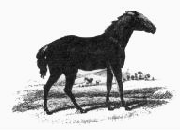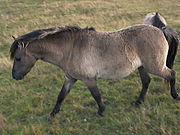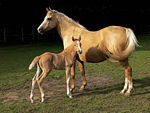Tarpan
| Tarpan | ||||||||||||||||||
|---|---|---|---|---|---|---|---|---|---|---|---|---|---|---|---|---|---|---|
 Only known photo of a live Tarpan, from the late 1800s
|
||||||||||||||||||
| Conservation status | ||||||||||||||||||
| Scientific classification | ||||||||||||||||||
|
||||||||||||||||||
| Trinomial name | ||||||||||||||||||
| Equus ferus ferus Boddaert, 1785 |
The Tarpan, Equus ferus ferus, was the Eurasian wild horse. The last specimen of this species died in captivity in Ukraine in 1876. The name Tarpan is from a Turkic language (Kyrgyz or Kazakh) name for the horse.[1]
Several attempts have been made to re-create the Tarpan, beginning in the 1930s. The breeds that resulted included the Heck horse, the Hegardt or Stroebel's horse, and a derivation of the Konik breed - all of which closely resembled the original Tarpan.
Contents |
Taxonomy
The Tarpan was first described by Johann Friedrich Gmelin in 1774; he had seen the animals in 1769 in the region of Bobrovsk, near Voronezh. In 1784 Pieter Boddaert named the species Equus ferus, referring to Gmelin's description. Unaware of Boddaert's name, Otto Antonius published the name Equus gmelini in 1912, again referring to Gmelin's description. Since Antonius' name refers to the same description as Boddaert's it is a junior objective synonym.

It is now thought that the domesticated horse, named Equus caballus by Linnaeus in 1758, is descended from the Tarpan; indeed, many taxonomists consider them to belong to the same species. By a strict application of the rules of the International Code of Zoological Nomenclature, the Tarpan ought to be named E. caballus, or if considered a subspecies, E. caballus ferus. However, biologists have generally ignored the letter of the rule and used E. ferus for the Tarpan to avoid confusion with its domesticated cousins.
In 2003, the International Commission on Zoological Nomenclature "conserved the usage of 17 specific names based on wild species, which are pre-dated by or contemporary with those based on domestic forms", confirming E. ferus for the Tarpan. Taxonomists who consider the domestic horse a subspecies of the wild Tarpan should use Equus ferus caballus; the name Equus caballus remains available for the domestic horse where it is considered to be a separate species.[2]
History
The Tarpan is a prehistoric wild horse type that ranged from Southern France and Spain east to central Russia. There are cave drawings of what are believed to be Tarpans in France and Spain, as well as artifacts believed to show the breed in southern Russia, where Scythian nomads domesticated a horse of this type around 3000 BC.[3]
The wild Tarpan horse died out during the late 1800s, and the last captive Tarpan died in 1876 on a Ukranian game preserve in Askania Nova. An attempt was made by the Polish government to save the Tarpan type by establishing a preserve for animals descended from the Tarpan in a forested area in Bialowieza. These descendents are today sometimes referred to as the Polish Primitive Horse.[3]
Recreation of type

There have been three attempts have been made to re-create the Tarpan. In the early 1930s, Berlin Zoo Director Lutz Heck and Heinz Heck of the Munich Zoo began a program that by the 1960s produced the Heck horse. In 1936, Polish university professor Tadeusz Vetulani began a program using Konik horses, and in the mid-1960s Harry Hegard started a program in the United States using feral mustangs and local working ranch horses that has resulted in the Hegardt or Stroebel's Horse. None of the breeding programs were completely successful, although all three resulted in horses with many similarities to the Tarpan.[4]
References
- ↑ Merriam-Webster Unabridged - Tarpan; Vasmer's Etymological Dictionary - Tarpan
- ↑ International Commission on Zoological Nomenclature (2003). Opinion 2027 (Case 3010). "Usage of 17 specific names based on wild species which are pre-dated by or contemporary with those based on domestic animals (Lepidoptera, Osteichthyes, Mammalia): conserved." Bulletin of Zoologic Nomenclature, 60:81-84.
- ↑ 3.0 3.1 "Tarpan". Breeds of Livestock. Oklahoma State University. Retrieved on 2008-10-07.
- ↑ The Extinction Website. "Equus ferus ferus". Recently Extinct Animals. The Extinction Website. Retrieved on 2008-07-09.
See also
- Przewalski's Horse
- Domestication of the horse
- List of extinct animals of Europe
- Žemaitukas
External links
- The Spanish Tarpan
- The Spanish Tarpan in North America
- American "Tarpan"
- North American Tarpan Association
|
||||||||||||||||||||
